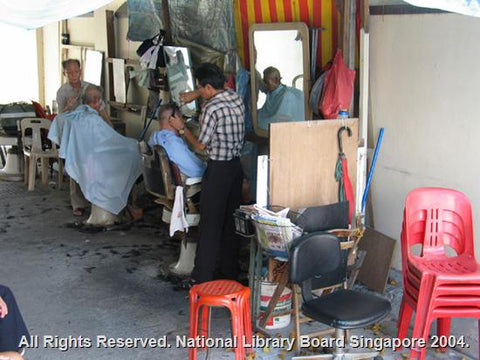
Background
Roadside barbers used to be a common sight in Singapore, operating mainly out of makeshift sheds with walls of wooden planks, and wooden roofs or awnings.1 Also known as street barbers or five-foot-way barbers, they offer fuss-free trims in back alleys.2
History
Roadside barbers were commonly found along Singapore’s streets and back lanes.3In the 1950s, the bustling side lane in Bugis was dubbed “Barber Street” as many barbers vied for customers there.4 They were also found along a cobbled lane that served as a link between Jalan Sultan and North Bridge Road. The lane was called the “Barber Row”.5 Most barbers were either Malays, Indians or Chinese.6 The barber shop often had a small, beaten tarpaulin canopy for a roof, below which was the shop.7 The space between two canopies acted as a territorial boundary. The shops usually consisted of a few old-fashioned chairs, a box-like cupboard hung on the wall, a small wall mirror and a few plastic bins filled with water.8 Most barbers were usually self-taught, although some picked up the trade by working as an apprentice under an established barber.9
Job scope
Barbers usually started work in the morning and continued to work until dusk.10When it became too dark to continue work, they packed up for the day.11 Their daily earnings depended on the weather, as rainy days saw fewer customers.12 Their charges went up during the Chinese New Year season, as it was customary for the Chinese to begin their new year with a fresh haircut.13 The Chinese have a tradition of shaving a baby’s head bald in the initial few weeks or months. On such occasions, the barbers usually made a home call and were paid extra for their service.14
Roadside barbers also cleaned ears.15 They used a five-centimetre-long metal ear cleaner that had a hook at one end to fish out the ear wax. After that a small fluffy brush was swished around the middle ear for the final clean-up.16 Apart from cleaning ears, Chinese barbers also used to clean the tongue and nose.17 Indian barbers gave their customers a good massage with their strong fingers and palms on their scalps.18 They also massaged their clients’ faces and shoulders.19
Developments
Roadside barbers are almost non-existent today except for an odd stall or two in locations such as Katong, Kim Keat Lane, Chinatown and Amoy Street.20 Their haircuts are inexpensive and very affordable, which is why they still attract a loyal clientele.21 These traditional barbers face stiff competition from unisex hair salons.22 Upscale barber shops offering haircuts and other grooming services have become the popular choice among men in their mid-20s to 50s.23
Author
Thulaja Naidu

1条评论
Mia on
What is the name of the barber in the photo